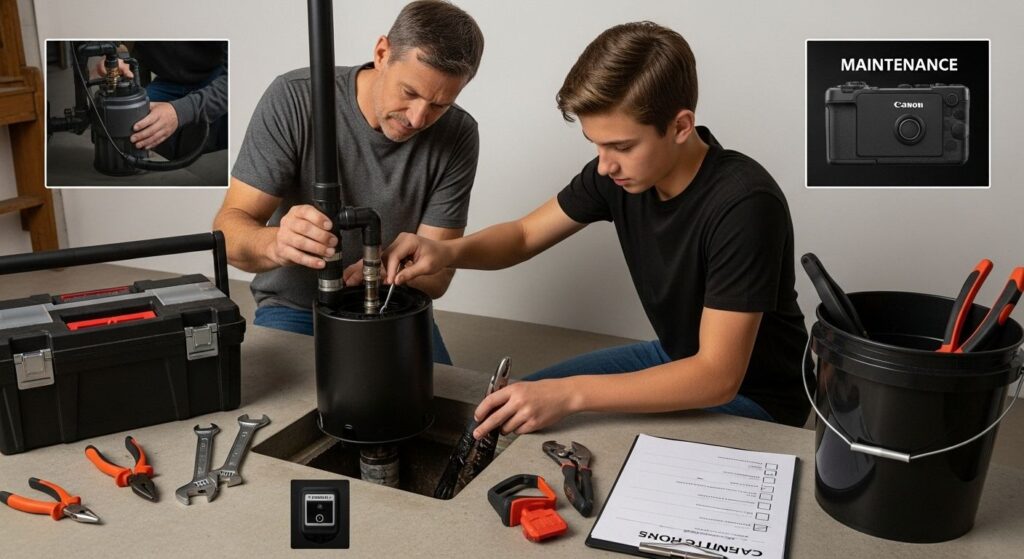A sump pump can save your basement from disaster and yet, many homeowners forget basic upkeep until it is too late. It might surprise you that a single failed sump pump can cause thousands of dollars in water damage even though it only takes a few minutes per month to keep one running smoothly. The real shock is most of these costly floods are totally preventable with simple checks you can start doing today.
Table of Contents
- Check The Power Supply Regularly
- Inspect The Sump Pit For Debris
- Test Your Sump Pump Monthly
- Clean The Pump And Discharge Pipe
- Schedule Annual Professional Maintenance
- Monitor For Unusual Noises Or Vibration
- Know When To Replace Your Sump Pump
Quick Summary
| Takeaway | Explanation |
|---|---|
| Check Power Supply Regularly | Ensure the sump pump has a stable power source to prevent flooding risks. Regular inspections can prevent malfunctions during critical times. |
| Inspect Sump Pit for Debris | Clear out any debris in the sump pit to maintain optimal pump performance and avert potential flooding. Regular cleaning is essential for preventing blockages. |
| Test Your Sump Pump Monthly | Simulate flooding to ensure your sump pump activates and performs properly. Monthly tests help identify issues before they lead to costly repairs. |
| Schedule Annual Professional Maintenance | Have a professional check your sump pump to catch issues beyond basic homeowner maintenance. Annual inspections help prolong the pump’s life and effectiveness. |
| Monitor for Unusual Noises or Vibration | Pay attention to unusual sounds or vibrations from your sump pump, as these may indicate mechanical problems requiring immediate attention. |
1: Check the Power Supply Regularly
A sump pump represents a critical line of defence against basement flooding, and its operational reliability hinges directly on consistent power supply. Without proper electrical connectivity, your home becomes vulnerable to water damage, making routine power checks an essential preventive maintenance strategy.
Homeowners must understand that sump pumps draw significant electrical current and require dedicated, stable power sources. According to InterNACHI’s Sump Pump Operation and Inspection Guide, ensuring uninterrupted electrical supply is paramount for effective water management.
When conducting power supply inspections, focus on several key aspects:
-
Verify electrical cord integrity: Check for any visible fraying, cracking, or damage to the power cord
-
Test outlet functionality: Confirm the dedicated outlet provides consistent voltage and is not connected to circuits prone to tripping
-
Inspect ground connections: Ensure proper grounding to prevent electrical shorts or potential system failures
Beyond visual inspections, homeowners should periodically test their sump pump’s electrical performance. This involves unplugging the unit, examining the cord and plug for wear, and confirming secure connections. Loose or damaged electrical components can compromise the pump’s ability to activate during critical moments.
Consider installing a battery backup system or secondary power source to mitigate risks during electrical outages. This additional layer of protection ensures continuous water management even when primary power sources fail, providing homeowners with increased peace of mind during severe weather conditions.
Regular power supply maintenance not only prevents potential flooding but also extends the overall lifespan of your sump pump. By dedicating time to these essential electrical checks, you safeguard your property against water-related damage and maintain the critical infrastructure protecting your home’s foundation.
2: Inspect the Sump Pit for Debris
A sump pit filled with debris represents a significant risk to your home’s water management system. Regular inspection and cleaning of the sump pit are crucial preventative maintenance steps that protect against potential flooding and pump malfunction.
According to FEMA’s home maintenance guidelines, homeowners should thoroughly examine their sump pit for potential obstructions that could impede the pump’s performance. Debris accumulation can seriously compromise the pump’s ability to effectively remove water from your basement.
When conducting a sump pit inspection, pay attention to these critical elements:
-
Check for sediment buildup: Accumulated dirt, gravel, and organic materials can block pump mechanisms
-
Remove foreign objects: Clear out rocks, construction debris, or any items that might have fallen into the pit
-
Inspect pit walls: Look for signs of erosion, cracking, or structural deterioration
Proper cleaning techniques involve carefully removing loose debris using a small hand tool or wet vacuum. Avoid using sharp metal implements that might damage the pump or pit lining. For comprehensive maintenance, learn more about preventing basement water damage to understand the broader context of sump pit care.
Professional plumbers recommend conducting these inspections at least twice annually, with additional checks following significant rainfall or during seasonal transitions. Proactive maintenance prevents potential costly water damage and ensures your sump pump operates at peak efficiency.
Remember that a clean sump pit not only protects your property but also extends the operational lifespan of your sump pump. By dedicating time to regular inspections, you create a robust defence against potential water intrusion and basement flooding.
3: Test Your Sump Pump Monthly
Monthly sump pump testing is a critical maintenance practice that prevents unexpected failures and ensures your home remains protected against potential water damage. Routine testing allows homeowners to identify potential issues before they escalate into costly emergencies.
According to North Dakota State University Extension, regular sump pump assessments are essential for maintaining optimal performance and preventing basement flooding. Homeowners should develop a consistent testing routine that verifies the pump’s operational readiness.
When conducting monthly sump pump tests, follow these essential steps:
-
Simulate flooding conditions: Pour several gallons of water into the sump pit to trigger pump activation
-
Observe pump response: Verify the pump starts quickly and efficiently removes water
-
Check drainage patterns: Ensure water is being properly discharged away from your home’s foundation
Professional maintenance insights suggest paying close attention to the pump’s sound, speed, and water displacement during testing. Unusual noises, sluggish water removal, or incomplete drainage could indicate underlying mechanical problems that require immediate attention.
Learn more about advanced sump pump maintenance techniques to enhance your understanding of comprehensive system care. Homeowners should document each monthly test, recording observations about the pump’s performance, which can help track potential deterioration over time.
Beyond visual inspections, consider testing your sump pump during different seasons. Spring and autumn are particularly crucial periods when precipitation levels fluctuate and potential water intrusion risks increase. Proactive monthly testing transforms your sump pump from a passive water management tool into an actively monitored home protection system.
Remember that a few minutes of monthly testing can save thousands of dollars in potential water damage repairs. Consistent monitoring ensures your sump pump remains a reliable guardian against basement flooding.
4: Clean the Pump and Discharge Pipe
Maintaining a clean sump pump and discharge pipe is crucial for preventing water damage and ensuring optimal system performance. Accumulated debris and sediment can significantly impair your pump’s efficiency and potentially lead to complete system failure.
According to FEMA’s home maintenance guidelines, homeowners should perform comprehensive cleaning of their sump pump system at least annually. This process involves carefully removing the pump, inspecting its components, and thoroughly cleaning both the pump and its surrounding infrastructure.
When cleaning your sump pump and discharge pipe, focus on these critical maintenance steps:
-
Disconnect electrical power: Ensure complete safety before beginning any cleaning procedure
-
Remove accumulated sediment: Carefully extract dirt, gravel, and organic materials from the pump and pit
-
Inspect discharge pipe: Check for blockages, cracks, or potential routing issues that could impede water flow
Professional plumbers recommend using a garden hose with moderate water pressure to clean the pump’s exterior. Avoid using harsh chemicals or abrasive cleaning tools that might damage delicate pump mechanisms. Explore our comprehensive guide on preventing water damage for additional insights into effective maintenance techniques.
Discharge pipe maintenance requires equal attention. Ensure the pipe directs water at least 10 feet away from your home’s foundation, preventing potential water re-entry and foundation erosion. Look for signs of ice buildup during winter months, which can obstruct water drainage and compromise the entire system.
Regular cleaning not only extends your sump pump’s operational lifespan but also provides an opportunity to detect potential mechanical issues before they escalate. By dedicating time to thorough cleaning and inspection, homeowners can significantly reduce the risk of unexpected pump failure and costly water damage repairs.
5: Schedule Annual Professional Maintenance
Professional sump pump maintenance represents a critical investment in protecting your home’s foundation and preventing potentially catastrophic water damage. While homeowner-level maintenance is essential, an annual inspection by trained professionals provides a comprehensive assessment that goes beyond routine checks.
According to FEMA’s home maintenance guidelines, homeowners should have their sump pump system professionally evaluated annually, with special attention to components that may deteriorate over time. Professional technicians can identify subtle issues that might escape an untrained eye.
During a professional maintenance visit, experts typically conduct these critical evaluations:
-
Comprehensive system diagnostic: Thoroughly test pump performance under various conditions
-
Mechanical component inspection: Check motor, float switch, and electrical connections for potential wear
-
Evaluate drainage efficiency: Assess discharge pipe routing and water expulsion capabilities
Professional maintenance offers several significant advantages beyond basic homeowner inspections. Trained technicians use specialized diagnostic tools to measure pump efficiency, detect potential mechanical weaknesses, and recommend preemptive repairs before system failure occurs.
Explore our comprehensive maintenance service options to understand how professional oversight can extend your sump pump’s operational lifespan. Most manufacturers recommend annual inspections to maintain warranty coverage and ensure optimal performance.
The cost of a professional maintenance visit is minimal compared to the potential expenses associated with basement flooding. A single professional inspection can prevent thousands of dollars in water damage repairs, making it a wise and strategic investment in your property’s long-term protection.
Remember that sump pumps are complex mechanical systems requiring expert knowledge. By scheduling annual professional maintenance, you transform reactive repair strategies into proactive protection mechanisms for your home.
6: Monitor for Unusual Noises or Vibration
Unusual sump pump sounds and vibrations are critical warning signals that should never be ignored. These mechanical indicators often reveal underlying problems that could potentially lead to complete system failure if left unaddressed.
According to FEMA’s home maintenance guidelines, homeowners should pay close attention to their sump pump’s operational sounds and physical behaviour. Mechanical anomalies can signal imminent system breakdown and require immediate investigation.
When assessing your sump pump’s operational condition, watch for these potential warning signs:
-
Grinding or rattling noises: Potential indication of damaged impeller or bearing wear
-
Persistent vibration: Suggests misalignment or mechanical component damage
-
Intermittent cycling: May reveal electrical or float switch malfunction
Professional diagnostic techniques involve carefully listening to the pump’s operational sounds and observing its vibrational patterns. Subtle changes in pitch, rhythm, or intensity can reveal complex mechanical issues that might escape casual observation.
Learn more about professional pump maintenance strategies to understand how expert assessment can prevent potential system failures. Modern sump pumps are sophisticated mechanical systems that require nuanced understanding.
Unexplained operational changes should prompt immediate professional evaluation. Vibrations and unusual sounds represent your sump pump’s method of communicating potential internal problems. Ignoring these signals could result in catastrophic water management system failure, potentially exposing your property to significant flooding risks.
Proactive monitoring transforms your sump pump from a passive water removal device into an actively managed home protection system. By developing a keen awareness of your pump’s operational characteristics, you can anticipate and prevent potential mechanical failures before they escalate into costly emergencies.
7: Know When to Replace Your Sump Pump
Recognizing the right time to replace your sump pump can prevent catastrophic water damage and protect your home’s structural integrity. Not all pump failures are immediately apparent, making proactive replacement a critical homeowner responsibility.
According to FEMA’s home maintenance guidelines, homeowners should consider sump pump replacement based on several key performance indicators. Age and operational reliability are primary considerations in determining whether a system requires complete replacement.
Watch for these critical signs suggesting your sump pump needs replacement:
-
Frequent cycling: Pump turns on and off more frequently than normal
-
Advanced age: Pump is older than 7-10 years
-
Increasing repair frequency: Requires multiple repairs within a short timeframe
Modern sump pumps offer significant technological improvements compared to older models. Explore our comprehensive maintenance strategies to understand when upgrading becomes more cost-effective than continual repairs.
Professional plumbers recommend establishing a proactive replacement strategy. Waiting for complete pump failure can result in thousands of dollars of water damage. Consider replacement if your current pump demonstrates reduced performance, unusual noises, or inconsistent water removal capabilities.
Additionally, homeowners should factor in their specific environmental conditions. Regions with high water tables, frequent flooding, or significant seasonal precipitation may require more frequent sump pump replacements. Understanding your local geological and climate challenges helps determine optimal replacement timelines.
Remember that a sump pump is not just a mechanical device but a critical line of defence protecting your home’s foundation and interior spaces. Investing in timely replacement ensures continuous, reliable water management and provides peace of mind during potential flooding scenarios.
Below is a comprehensive table summarizing the 7 key sump pump maintenance tips detailed in this article, including main actions, their purpose, and important notes to help protect your home from water damage.
| Maintenance Tip | Purpose/Benefit | Key Steps or Notes |
|---|---|---|
| Check Power Supply Regularly | Prevents unexpected pump failure due to power issues | Inspect cords, outlets, and grounding; install backup power; check regularly to ensure readiness |
| Inspect Sump Pit for Debris | Ensures efficient operation and prevents blockages | Remove sediment, rocks, debris; check pit walls; inspect at least twice a year or after heavy rain |
| Test Your Sump Pump Monthly | Detects issues early and ensures system activates as needed | Simulate flooding; observe activation and drainage; listen for odd sounds; document/test every month |
| Clean Pump and Discharge Pipe | Prevents build-up that can impair pump and discharge effectiveness | Disconnect power; remove pump and debris; check discharge for clogs; clean annually or as needed |
| Schedule Annual Professional Maintenance | Identifies hidden issues and prolongs pump lifespan | Hire a professional; comprehensive system check; helps maintain warranty |
| Monitor for Unusual Noises or Vibration | Catches mechanical problems before they escalate | Listen for grinding, rattling, excess vibration; act quickly if changes are noticed |
| Know When to Replace Your Sump Pump | Avoids major failures and flood risk due to aging equipment | Replace if pump is 7-10+ years old, frequent cycling, or repeated repairs; upgrade when needed |
Protect Your Home With Trusted Sump Pump Maintenance Experts in Ottawa
You have just learned practical steps to prevent water damage and basement floods, but maintaining your sump pump consistently and correctly can still feel overwhelming. Many homeowners worry about missing hidden problems like debris buildup, power issues or early signs of pump failure. Even after testing your system and cleaning the pit, ensuring real peace of mind often calls for an expert touch. Your goal is simple: keep your basement dry, your home protected, and avoid costly emergencies. We understand that feeling.

Skip the stress and let Ottawa’s plumbing professionals handle the tough parts for you. Our team at Delta Plumbers delivers prompt, thorough sump pump maintenance and total plumbing care across the city. With flat-rate pricing, same-day service and a full one-year warranty, you get expert help without the hassle. See more on our service overview and book your maintenance today. Do not wait until the next heavy rain to discover a problem. Take action now and keep your home protected all year round.
Frequently Asked Questions
What routine checks should I perform on my sump pump?
You should regularly check the power supply integrity, inspect the sump pit for debris, and test the pump’s functionality at least once a month to ensure it operates effectively.
How often should I clean my sump pump and discharge pipe?
It is recommended to clean your sump pump and discharge pipe at least once a year to remove accumulated debris and prevent operational issues.
What are the signs that indicate my sump pump needs to be replaced?
Key indicators of sump pump replacement include frequent cycling, the pump exceeding 7-10 years of age, and an increase in repair frequency or operational inefficiency.
Why is professional maintenance important for sump pumps?
Professional maintenance ensures a comprehensive evaluation of your sump pump system, identifying potential problems that might go unnoticed during regular checks, ultimately preventing costly water damage.









